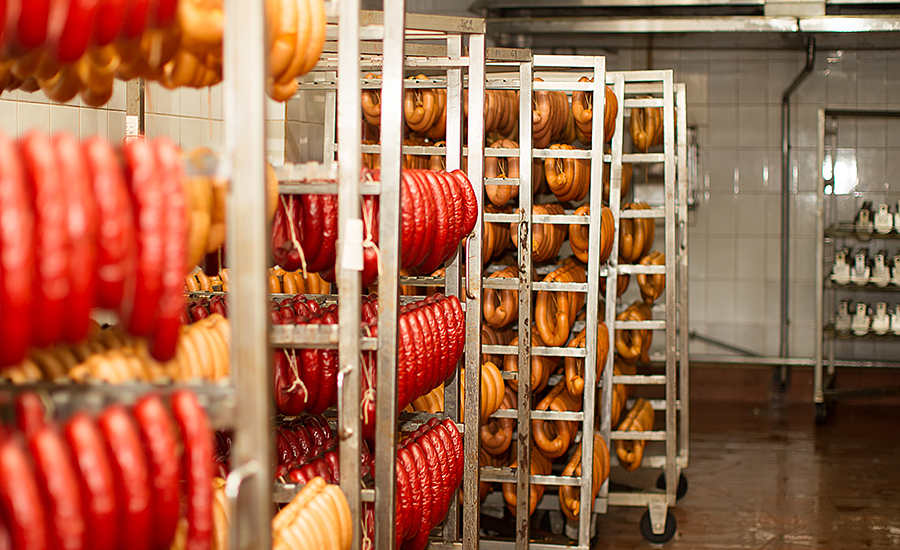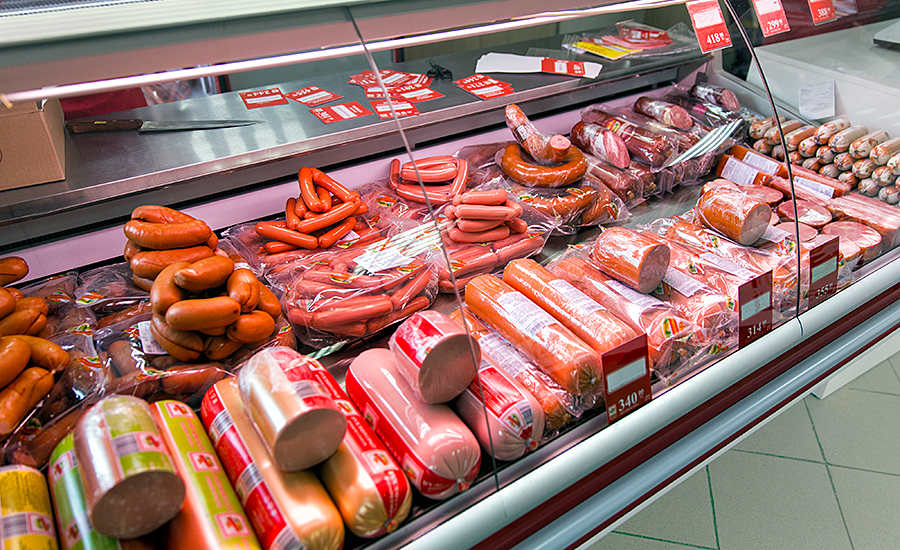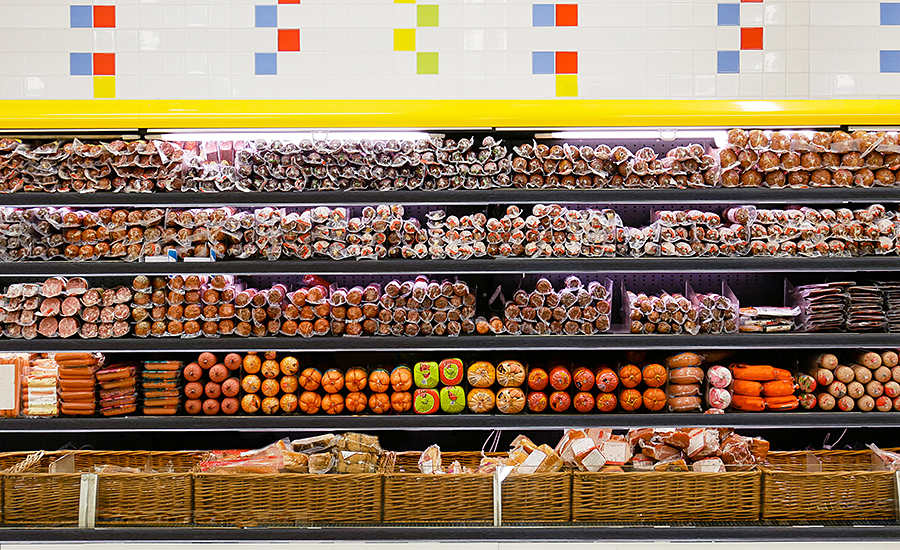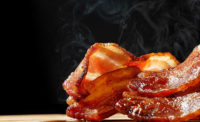It is a sensational time to be a sausage seller.
Similar to many other meat products, sausage sales are booming as a huge portion of the population eats more meals at home in response to the COVID-19 pandemic and the closure of restaurants. Sausage’s attractive cost and easy preparation are contributing to product sales that are outpacing the growth rate of the meat sector as a whole.
Sausage revenues for both fixed- and random-weight items were up 44.7 percent for the four weeks ending May 17 versus the year earlier period, according to Information Resources Inc. (IRI), a Chicago-based market research firm. Total meat sales grew 42.6 percent during that time, while frankfurter revenues rose 31.5 percent, IRI reports.
Also contributing to sausage’s strong appeal is product familiarity and a wide range of flavors and varieties, says Chris DuBois, IRI senior vice president of the protein practice.
“The sausage category is attracting millions of buyers who haven’t been there before or who haven’t bought sausage in the last year,” he says. “Manufacturers have a fantastic chance to market to those new buyers and learn what the consumers like and don’t like, which will enable them to take the proper steps to drive further growth over the next few years. Marketers that get after the category can win big.”
Chart Index
Price, meanwhile, also is a strong sales driver with the retail cost of sausages and hot dogs typically lower than that of other fresh meats, such as steaks, chicken breasts, pork chops and bacon, says John Madigan, lead industry research analyst for IBISWorld, a Los Angeles-based market research firm, citing the company’s March 2020 Hot Dog and Sausage Production report.
“When meat prices rise across the board, budgeting consumers switch from pricier meats to hot dogs and sausages,” Madigan says. “Conversely, when meat prices decline, consumers do not abandon hot dogs and sausages for steaks and burgers. This dual appeal, both in terms of pricing value and product preference, helps keep the industry from being overly volatile and enable profit margins to remain fairly stable.”
Category products include dinner sausages such as Italian sausage and bratwurst, hot dogs, dry sausages such as pepperoni and salami, and breakfast sausages in both links and patties, Madigan says, adding that while most selections are made from pork or beef, a growing share also features poultry.
Research conducted this year on sausage popularity by the Des Moines, Iowa-based National Pork Board (NPB) found that 54 percent of consumers report using pork sausage once a month or more often and 35 percent of consumers say they usually have pork sausage on hand either in the refrigerator or freezer.

Prepare for the unplanned
Sausage is particularly attractive to impulse buyers, which makes it vital for retailers to put products in highly visible store locations, such as in bunkers near the meat case and aisles with heavy shopper traffic, DuBois says.
Retailers also can boost sausage-related revenues through cross merchandising, which includes situating associated items such as buns, sauerkraut and exotic mustards close to the sausage displays, he says. “It is important that the secondary items are visible and not located 75 feet away from the sausages as many shoppers will not go out of their way for the products, and that will result in blown sales,” DuBois says.
Frozen Sausage Sales
Top 5 Companies
| COMPANY | DOLLAR SALES | % CHANGE | SHARE | UNIT SALES | % CHANGE |
| Conagra Brands | $170.4 | 12.1 | 32.8 | 99.3 | 8.4 |
| Private Label | $89.2 | 10.4 | 17.1 | 15.6 | 8.1 |
| Applegate Farms Inc. | $45.4 | 31.2 | 8.7 | 9.0 | 29.9 |
| Hillshire Brands Co. | $43.2 | 31.2 | 8.3 | 8.1 | 31.8 |
| Jones Dairy Farm | $40.6 | 15.0 | 7.8 | 14.0 | 9.1 |
Top 10 Brands
| COMPANY | DOLLAR SALES | % CHANGE | SHARE | UNIT SALES | % CHANGE |
| Banquet Brown 'N Serve | $166.4 | 11.7 | 32.0 | 98.2 | 8.3 |
| Private Label | $89.2 | 10.4 | 17.1 | 15.6 | 8.1 |
| Applegate Naturals | $42.6 | 30.2 | 8.2 | 8.5 | 29.4 |
| Purnell Old Folks | $40.2 | 6.2 | 7.7 | 4.9 | 2.2 |
| Jimmy Dean | $39.6 | 44.3 | 7.6 | 7.7 | 38.6 |
| Jones Golden Brown | $30.2 | 15.4 | 5.8 | 11.2 | 8.0 |
| Smithfield | $16.0 | 46.6 | 3.1 | 4.8 | 46.8 |
| Williams | $15.8 | 4.8 | 3.0 | 2.6 | -3.0 |
| Ole South | $9.3 | 20.3 | 1.8 | 2.0 | 20.7 |
| Jones Dairy Farm | $8.9 | 22.3 | 1.7 | 2.4 | 19.4 |
| Total Category | $520.5 | 12.8 | 100 | 171.9 | 7.2 |
Source: IRI, a Chicago-based market research firm. Total U.S. multi-outlet (grocery, drug, mass market, military and select club & dollar retailers). Figures are for 52 weeks ending May 17. Rankings of the top brands are not total brands (e.g. all brand lines/extensions rolled up into a single figure), but rather individual brand lines.
↑---------Back to Top---------↑
The most successful sausage merchandisers create “a sense of theater” by using secondary displays that feature sausage ingredients and other items such as rolls, vegetables and tortilla chips that together make an attractive meal and inspire on-the-spot purchases, says Dana Ehrlich, chief executive officer of Verde Farms, a Woburn, Mass.-based supplier of 100-percent grass-fed, free-range beef sausage.
“Retailers that serve up new and well-thought-out meal ideas at the point of sale can make a consumer’s life easier in terms of planning and initiate unplanned new product trials as well,” he says. Ehrlich says sausage also is attractive to many shoppers as the products inspire a sense of mealtime nostalgia and that global inspired flavors can add excitement to meals.
“That is evidenced by more brands bringing out selections that seek to reconcile consumer values with culinary evolution,” he says. “More consumers want culinary adventures without sacrificing their product values.” Such values include only eating meats that come from humanely raised animals and from suppliers that respect the environment, Ehrlich says.
“The way forward is to develop products that achieve both through innovation and a new approach to sourcing in which the health of the consumer, animal and the environment are top priorities,” he says.

Keep marketing and advertising
The current strong sales activity should not deter merchandisers from aggressively marketing products, DuBois says.
Though the strong demand for sausage makes it challenging for many retailers to keep cases stocked, spotlighting specific items will keep brands in the minds of consumers, particularly among newer category buyers, DuBois says.
“Merchandisers should invest in brands to maintain loyalty among existing shoppers and to connect with new ones,” says Anne-Marie Roerink, president of 210 Analytics, a San Antonio-based market research and marketing strategies firm. “Mining sales data from the past two months is a great way to understand the category strengths on which to focus.”
Refrigerated Breakfast Sausage/Ham Sales
Top 5 Companies
| COMPANY | DOLLAR SALES | % CHANGE | SHARE | UNIT SALES | % CHANGE |
| Hillshire Brands Co. | $612.6 | 9.6 | 31.1 | 153.5 | 8.3 |
| Private Label | $232.3 | 16.4 | 11.8 | 87.4 | 14.8 |
| Johnsonville Sausage LLC | $223.6 | 6.1 | 11.4 | 65.8 | 4.3 |
| Bob Evans Farms Inc. | $195.8 | 8.9 | 9.9 | 51.5 | 5.4 |
| Conagra Brands | $123.0 | 11.6 | 6.2 | 32.4 | 9.0 |
Top 10 Brands
| COMPANY | DOLLAR SALES | % CHANGE | SHARE | UNIT SALES | % CHANGE |
| Jimmy Dean | $608.7 | 9.6 | 30.9 | 152.7 | 8.3 |
| Private Label | $232.3 | 16.4 | 11.8 | 87.4 | 14.8 |
| Johnsonville | $221.0 | 6.1 | 11.2 | 65.1 | 4.3 |
| Bob Evans Farm Fresh Goodness | $125.6 | 9.7 | 6.4 | 34.1 | 6.2 |
| Odom’s Tennessee Pride | $119.9 | 11.9 | 6.1 | 31.5 | 9.3 |
| Swaggerty’s Farm | $80.1 | 22.4 | 4.1 | 12.8 | 15.9 |
| Farmer John | $36.6 | 7.0 | 1.9 | 23.8 | 4.5 |
| Hatfield | $33.7 | 9.0 | 1.7 | 12.1 | 2.0 |
| Owens | $32.4 | 9.4 | 1.7 | 8.6 | 7.2 |
| Bob Evans | $30.5 | 7.6 | 1.6 | 6.5 | 2.5 |
| Total Category | $1,969.3 | 10.9 | 100 | 571.5 | 8.0 |
↑---------Back to Top---------↑
Roerink notes that the most appealing selections will include those that make meal preparation easier for consumers.
“The sausage segment is ideally positioned for convenience as sausage is easy and fast to make and shoppers can easily pair sausage with a multitude of items that they may have in their pantries, fridges or freezers,” Roerink says. “Versatility and speed are more important traits as there are many additional at-home meal occasions. Easy, quick meals are in rotation along with scratch cooking and experimentation.”
It also important for retailers to offer a mix of popular flavors and recent innovations to create new buying patterns while spurring impulse purchases, she says. “Routine is a big enemy for the meat department,” Roerink says. “People get bored with cooking the same meals with the same varieties.”
Sausage merchandisers can respond to consumers’ growing desire for diversity by offering sausage products that contain different proteins and ingredients and come in various shapes and sizes, she says.
“Successful brands also offer products for all meal occasions, which is a fit for sausage as it is versatile from breakfast to dinner and as a snack,” Roerink says. “Continuous innovation is important for prompting trial, particularly because of sausage’s role as a versatile, kid-friendly item that is fit for everyday meals and cookouts.”
With many more consumers staying and working at home, the traditional three square meals a day are giving way to an increase in mini-meals and snacks, says Tom Super, senior vice president of the Washington, D.C.-based National Chicken Council. “Sausages are a great option for meeting that trend, and it will likely continue once the pandemic is history.”
Refrigerated Frankfurters Sales
Top 5 Companies
| COMPANY | DOLLAR SALES | % CHANGE | SHARE | UNIT SALES | % CHANGE |
| Hillshire Brands Co. | $611.5 | 15.7 | 23.6 | 160.0 | 11.0 |
| Kraft Heinz Co. | $440.0 | 5.7 | 17.0 | 142.1 | 5.3 |
| Bar S Foods Co. | $317.2 | 8.0 | 12.2 | 235.9 | 5.2 |
| Smithfield Packaged Meats | $307.5 | 18.5 | 11.9 | 77.0 | 14.4 |
| Conagra Brands | 180.7 | 7.0 | 7.0 | 38.0 | 3.8 |
Top 10 Brands
| COMPANY | DOLLAR SALES | % CHANGE | SHARE | UNIT SALES | % CHANGE |
| Ball Park | $597.9 | 16.7 | 23.1 | 155.8 | 12.0 |
| Oscar Mayer | $394.3 | 7.0 | 15.2 | 131.2 | 6.7 |
| Bar S | $313.8 | 8.8 | 12.1 | 235.3 | 5.5 |
| John Morrell Nathan’s Famous | 290.2 | 19.1 | 11.2 | 61.0 | 16.6 |
| Hebrew National | $180.7 | 7.0 | 7.0 | 38.0 | 3.8 |
| Private Label | $84.2 | 20.1 | 3.3 | 24.1 | -6.3 |
| Oscar Mayer Selects | $45.6 | -4.4 | 1.8 | 10.9 | -9.5 |
| Sabrett | $45.2 | 25.7 | 1.7 | 8.3 | 19.4 |
| Gwaltney | $35.7 | 5.5 | 1.4 | 23.0 | -1.2 |
| Eckrich | $25.3 | 7.8 | 1.0 | 15.5 | 7.1 |
| Total category | $2,593.7 | 10.6 | 100 | 875.5 | 5.3 |
Source: IRI, a Chicago-based market research firm. Total U.S multioutlet (grocery, drug, mass market, military and select club and dollar retailers). Figures are for 52 weeks ending May 17. Rankings of the top brands are not total brands (e.g. all brand lines/extensions rolled up into a single figure), but rather individual brand lines.
↑---------Back to Top---------↑
Boast about benefits
Greater and longer-lasting sausage sales also will result from getting shoppers to think outside the box in considering meal options, says Mel Coleman Jr., vice president of Coleman Natural Foods, a Westminster, Colo.-based supplier of natural and organic meat and poultry.
“Rather than simply looking at grilling occasions, it is important to encourage consumers to see sausage as a high-protein ingredient for breakfast, lunch, dinner and snacking,” he says. “Varieties and flavors are available to get that done and retailers also can offer inspiring recipes that reveal how consumers can stretch a single pack of sausages over a few meals. It will help shoppers get creative in the kitchen while maintaining their budgets.”
Ehrlich agrees: “Highlighting the versatility of sausage as a quick, easy, multiuse ingredient can bolster consumer engagement. That includes emphasizing its use in a host of recipes instead of just being singularly suited for the grill or summer season.”
Retailers can further boost activity by expanding their assortments and creating the case space for the additional varieties by reducing duplicate SKUs, he adds. The National Pork Board reports parmesan cheese, white truffle, pecorino and sriracha are the top growing dinner sausage flavors, while traditional, spiced apple and honey maple are the fastest-growing breakfast sausage flavors.
The launch of new and enticing flavors is important as consumers list taste as the most important factor when purchasing pork and other meat selections, followed by “good for me and my family,” the NPB says.
In addition, merchandising sausage in resealable packaging will enable retailers to better attract shoppers who seek sausage for snacking or mini meals and generate more repeat purchasing, Super says, adding that sausages in bite size portions that readily work in a microwave also will accentuate convenience.
Refrigerated Dinner Sausage Sales
Top 5 Companies
| COMPANY | DOLLAR SALES | % CHANGE | SHARE | UNIT SALES | % CHANGE |
| Johnsonville Sausage LLC | $872.2 | 13.6 | 21.9 | 212.0 | 9.3 |
| Hillshire Brands Co. | $673.7 | 10.1 | 16.9 | 197.2 | 5.9 |
| Private Label | $455.3 | 14.0 | 11.4 | 117.2 | 21.1 |
| Armour Eckrich Meats LLC | $339.1 | 17.3 | 8.5 | 102.6 | 12.9 |
| Aidells Sausage Co. | $110.9 | 12.5 | 2.8 | 20.0 | 14.2 |
Top 10 Brands
| COMPANY | DOLLAR SALES | % CHANGE | SHARE | UNIT SALES | % CHANGE |
| Johnsonville | $716.4 | 12.0 | 18.0 | 172.7 | 8.2 |
| Hillshire Farm | $524.7 | 12.6 | 13.2 | 155.0 | 8.4 |
| Private Label | $455.3 | 14.0 | 11.4 | 117.2 | 12.1 |
| Eckrich | $316.7 | 17.0 | 8.0 | 95.5 | 12.5 |
| Hillshire Farm Li'l Smokies | $143.9 | 4.2 | 3.6 | 40.8 | -0.6 |
| Johnsonville Beddar with Cheddar | $121.9 | 19.9 | 3.1 | 31.1 | 12.4 |
| Aidells | $108.7 | 10.3 | 2.7 | 19.6 | 11.8 |
| Premio | $98.5 | 6.4 | 2.5 | 20.3 | 4.6 |
| Bar S | $65.4 | 12.1 | 1.6 | 13.3 | 7.5 |
| Conecuh | $62.0 | 16.0 | 1.6 | 12.0 | 13.9 |
| Total category | $3,979.7 | 12.7 | 100 | 1,025.3 | 9.2 |
Source: IRI, a Chicago-based market research firm. Total U.S. multioutlet (grocery, drug, mass market, military and select club and dollar retailers). Figures are for 52 weeks ending May 17. Rankings of the top brands are not total brands (e.g. all brand lines/extensions rolled up into a single figure), but rather individual brand lines.
↑---------Back to Top---------↑
Select the optimal medium
Digital advertising is among the most cost-effective vehicles for spotlighting sausage selections, while in-store signage is key for reaching impulse purchasers and highlighting newer varieties, DuBois says.
“Pricing is less important because of the great demand for products, but cost and assortment will become more pertinent when restaurant dining comes back,” he says. “It is most important now for retailers to keep their sausage shelves full because of the great consumer interest in cooking at home. More shoppers are buying products at the full price.”
The stronger interest in sausage also is enabling merchandisers to generate more activity from first-time buyers without having to leverage such sales tools as sampling or couponing, DuBois says. “Having this many new buyers come into a category almost never happens,” he says. “It is every marketer’s dream come true. It is a fantastic time for sausage marketing as there are many new customers and lots of ways to talk to them.”
Other effective techniques for maintaining and enhancing shopper interest in sausage includes the use of short, simple, “reinforce messaging,” which can note, for instance, that sausage is great for the grill or smoking and is simple and quick to cook, says Tara Dugan, NPB director of consumer and marketplace insights. On-pack messaging spotlighting food safety and sustainability also can boost sales, she adds.
“Food-safety barriers hark back to how pigs are raised,” Dugan says. “Consumers are skeptical and want assurance that their food is raised consistently.”

Waffling on health and wellness
While food safety and health and wellness are top of mind for many shoppers, more of the consumers are overlooking such issues because of their desire to add variety to meals, DuBois says.
“Because sausage is tasty, reasonably priced and easy to cook, health often goes to the backburner,” he says. “With people cooking six or seven dinners a week at home, sausage is finding its way back into the rotation.”
Suppliers, however, still seek to appeal to health-conscious shoppers by launching and spotlighting selections with wellness claims including “organic,” “all natural” and “grass fed,” and offering more varieties of leaner proteins, such as chicken sausage and turkey sausage, Roerink says.
Sausages that contain simple, clean ingredients from humanely raised animals are becoming more popular and it is vital for merchandisers to feature such information on packages, Coleman says. He adds that education is key for generating more trial and repeat sausage purchases, particularly because consumers are ordering groceries online more often. Such shoppers typically spend more time reading labels than the in-store buyers who often face an overwhelming amount of options, he notes.
Sausage growth rate outpaces total meat sector
| PRODUCT | % CHANGE, 4 WEEKS | % CHANGE, 52 WEEKS | % CHANGE, YEAR TO DATE |
| Meat Total | 42.6% | 10.6% | 24.8% |
| Sausage | 44.7% | 11.7% | 27.2% |
| Frankfurters | 31.5% | 10.6% | 28.1% |
| Beef Total - Fresh | 48.8% | 11.6% | 26.7% |
| Beef Ground | 46.6% | 13.0% | 29.0% |
| Chicken Total | -29.4% | 9.0% | 19.0% |
| Chicken Whole Bird | 51.5% | 6.4% | 23.2% |
| Chicken Ground | 47.2% | 17.4% | 28.4% |
| Pork Total - Fresh | 44.1% | 10.0% | 25.2% |
| Pork Ground | 32.7% | 9.5% | 20.4% |
| Turkey Total - Fresh | 47.1% | 8.0% | 26.8% |
| Turkey Whole Bird | 122.2% | 1.5% | 70.0% |
| Turkey Ground | 43.6% | 10.6% | 23.3% |
| Smoked Ham/Pork | 34.7% | 10.6% | 30.2% |
| Bacon | 47.4% | 11.4% | 24.7% |
| Lamb | 23.6% | 5.9% | 12.5% |
| Veal | 16.7% | -4.5% | 3.7% |
| Exotic | 65.5% | 12.7% | 37.0% |
| All Other Total | -13.3 | -8.6 | -7.1 |
Source: IRI Syndicated Meat Database with both fixed- and random-weight items integrated. Figures are for the period ending May 17.
↑---------Back to Top---------↑
“It is important that each package tells a strong story,” Coleman says. “And merchandisers can share that story across all their digital channels.”
In late 2019, research commissioned by the National Pork Board showed the presence of fats and sodium nitrates in pork and the risk of cancer were chief consumer health concerns. The study involved the online monitoring of 16,000 pork conversations on social media.
“Health factors will continue to be a concern and operators will adopt to consumer preferences by developing new, more healthful options,” Madigan says. “Products traditionally made with red meat will be reinvented with poultry meat, a much leaner option. Companies also will make other adjustments, including decreasing sodium content or using organic meat products to appeal to changing consumer health preferences.” NP




